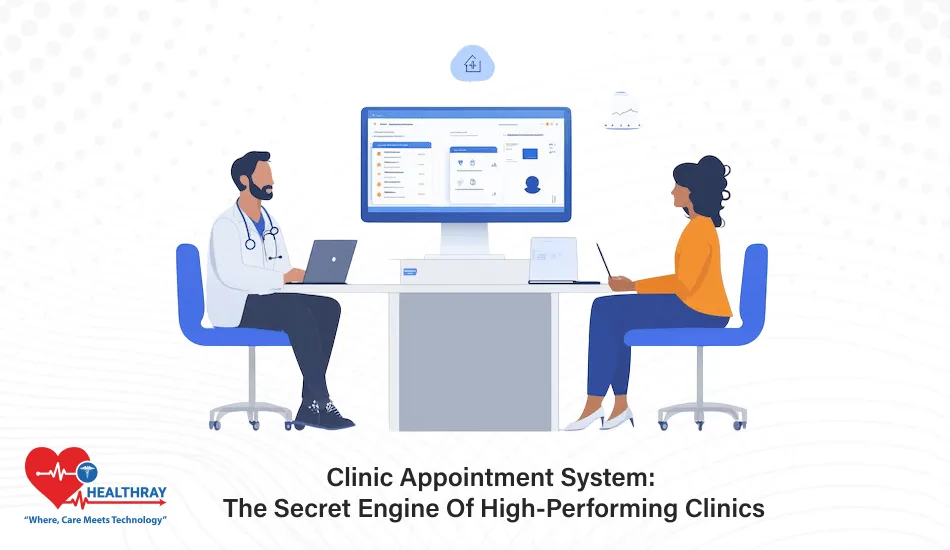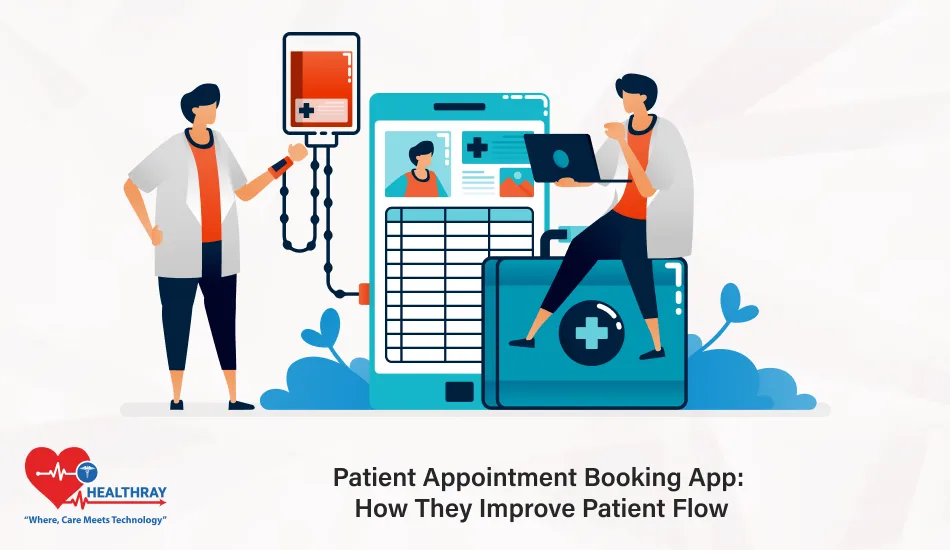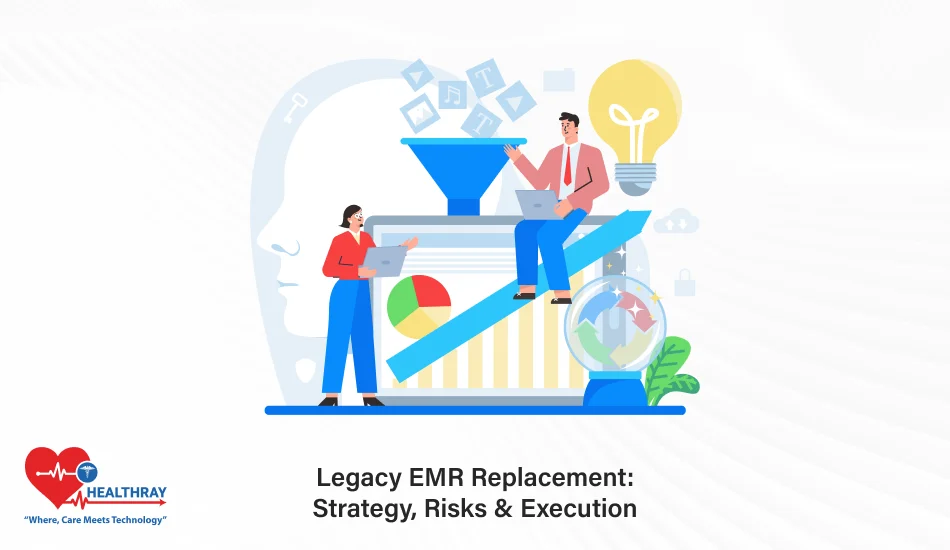Summary
This article will teach hospitals how to calculate their EHR software cost/value with the EHR ROI calculator & cost models. It walks the reader through important steps such as aggregate all costs, calculate savings, calculate time savings, decreased errors and speedier billing.
It also covers different cost models, provides a sample ROI calculation and explains how hospitals can compare vendors after seeing their ROI numbers. In addition, when using the EHR ROI calculator & cost models, the cost benefit is more evident to the healthcare teams resulting in an informed decision on the selection or upgrading of EHR software.
Introduction
Calculating return on EHR investment can often feel complicated and confusing, but there are simple ways to clarify the process. Since hospitals and clinics use EHR software daily, this leads us to view its value differently. Using the EHR ROI calculator & cost models, leaders can rapidly and systematically quantify actual gains.
Every decision in health care affects cost, speed, and patient experience. The ROI measurement also allows teams to assess savings, minimise errors and refine processes. Clear numbers support smarter budgeting, smoother planning, and better leadership decisions.
Cost models also reveal where money goes and where value grows. They present upfront costs, maintenance costs, and long-term savings in a straightforward manner. And with an EHR ROI calculator, teams will see results quickly and confidently.
What ROI Really Means in Healthcare?

ROI (Return on Investment) in healthcare tells you the true value behind each rupee spent. Moreover, it aids leaders in understanding how EHR software enhances patient care, reduces waste, and allows for seamless workflows.
Additionally, the ROI also demonstrates things like faster billing, fewer errors, and better team performance. Consequently, this allows hospitals to have numbers, rather than estimates, when utilizing an EHR ROI calculator & cost models. In this clarity, teams are able to budget, improve systems, and remove gaps in processes. Furthermore, ROI bills are also getting in the way of good technology decisions, especially in terms of finding the right EHR software or a secure EHR platform for PHI. Ultimately, ROI is an easy way to measure advancement and potential.
What’s the EHR ROI Calculator? Key Inputs You Must Know!
EHR ROI calculator & cost models help hospitals to measure value from EHR software. It uses simple numbers to show how much money is saved by the system and how much value it provides. They also help them to compare the best EHR software, EHR software pricing, as well as information about EHR software vendors in India.
In order for teams to accurately employ the calculator, they must have access to its critical inputs. These inputs assist teams in making decisions about the proper setup, such as whether they prefer a cloud system or a secure EHR platform for PHI.
Key Inputs You Must Enter
- Upfront software cost: This is the initial payment for purchasing or subscribing to the EHR software.
- Hardware costs: This would include computers, tablets, scanners, servers, or backup devices.
- Implementation cost: This includes training, setting up data migration and altering workflows.
- Maintenance and support cost: This shows the yearly cost for support, upgrades, and fixes.
- Staff productivity gains: This is the measurement of time savings for billing, charting, and daily work.
- Reduction in claim denials: Indicates the additional revenue achieved through clearer and quicker claims.
- Reduction in clinical errors: This indicates savings related to safer care and more accurate care.
- Faster billing cycles: This feature indicates how quickly the hospital receives the payments once the system has been used.
- Patient volume growth: This reflects improved workflows leading to higher patient visits per day.
If all of these inputs come in through the EHR ROI calculator & cost models, the hospitals have clear financial feedback. This helps them in identifying the best-suited EHR architecture, as well as in confidently comparing various EHR software vendors in India.
Understanding EHR Cost Models Before You Calculate ROI

Hospitals need to understand the four major EHR cost models before considering using the EHR ROI calculator & cost models.
Subscription Cost Model
- In this model, hospitals pay monthly or yearly fees.
- It works well for small and mid-size clinics.
- It reduces upfront cost and gives predictable spending.
- It includes updates and support in most cases.
- Teams can scale easily as they grow.
License (One-Time Purchase) Cost Model
- Hospitals pay once for the EHR software license.
- It offers full ownership and strong control.
- It suits large hospitals that want long-term stability.
- Maintenance fees still apply every year.
- It needs higher upfront cost but lower long-term recurring cost.
Hybrid Cost Model
- This model mixes subscription and licensing methods.
- It offers flexible payments and strong customization.
- It suits hospitals that want balance and long-term control.
- It works well with complex workflows.
- It supports both cloud and on-premise setups.
Cloud Cost Model
- This model keeps all data online in a secure cloud.
- It reduces hardware and server cost.
- It supports remote access anytime.
- It suits hospitals that want fast setup and low IT stress.
- It works perfectly for a secure EHR platform for PHI.
How to Calculate Your EHR ROI Like a Pro?
It’s easy to calculate ROI if teams have simple and clear steps to follow. In fact, the EHR ROI calculator & cost models provide the entire process end-to-end. They help hospitals understand real value, reduce waste, and speed up patient care. Therefore, here it is, the full step-by-step guide in clean and practical form.
Step 1: Collect All EHR Costs
Create a line item for every cost associated with the EHR software. For instance, think of hardware, training, monthly/yearly subscription or licensing, migration fees, and support on a yearly basis. Additionally, if the hospital employs its own data center, add server costs. Security layers should not be forgotten when the team is operating a secure EHR platform for PHI.
Consequently, this first step will help teams keep this in check. Furthermore, it also avoids missing hidden expenses that can throw future budgets off. Ultimately, the EHR ROI calculator & cost models will give all the right results when cost collection remains complete and systematic.
Step 2: List All Savings and Gains
Then, list every savings the EHR creates. Think faster billing, fewer errors, smoother workflows and less paperwork. Add improvements in patient volume and staff productivity. All those figures prove the system integrates better the daily hospital work.
These gains become more realistic when hospitals use the EHR ROI calculator & cost models. Leaders also see the monthly growth in value. This list constitutes a solid foundation for analyzing the best EHR software as well as comparing different EHR software vendors in India.
Step 3: Measure Time Saved
Time saved is always money saved. Therefore, calculate the amount of time saved in documentation, billing, reporting, and coordination with patients. For instance, five minutes spent per patient less is also a tremendous advantage over one year.
Consequently, this gives teams ideas about what to do with automation and intelligent workflows. Additionally, it brings out what tasks take up most time prior to the EHR deployment. As a result, time savings are apparent, and teams actually grasp the benefit of using the best EHR software in practice.
Step 4: Add Financial Impact of Fewer Errors
EHR systems cut down on clinical errors throughout several phases of care. Specifically, they improve prescription safety, eliminate handwriting issues, and help ensure accurate entry of data. Consequently, these advances cut costs and mitigate risks.
Therefore, add up the costs related to fewer mistakes. This includes savings from fewer duplicative tests, fewer wrong prescriptions, and better coding. Ultimately, these numbers are core to ROI in total because they indicate better value in patient safety and sounder clinical decisions. In addition, the EHR ROI calculator & cost models help teams to clearly visualise these benefits.
Step 5: Add Revenue from Faster Billing
EHRs have accelerated claims submission. Additionally, they cut down on denials. Furthermore, they improve coding accuracy and claims completeness. Consequently, all of these things create more monthly revenue for the hospital.
Now, let’s add the additional revenue brought in by the swifter cycle, which includes benefits from reduced denial and speedier approval. When numbers such as these are brought into the EHR ROI calculator & cost models, the financial picture becomes more robust and reliable. Moreover, this process also demonstrates the reason that so many teams find cloud-based systems, or a secure EHR platform for PHI, to improve data flow.
Step 6: Calculate Total Annual Savings
To begin with, add together any savings accrued in the previous steps. Specifically, include time saved, errors reduced, revenue increased, paperwork reduced, and efficiency.
Ultimately, this figure represents the annual overall increase after applying the EHR software. In addition, it shows how much the hospital saves in both money and operations. Consequently, leaders then use this number to compare their results with other hospitals or other vendors, especially when they are evaluating the best EHR software in the market.
Step 7: Calculate Total Annual Costs
The next step is to calculate the annual costs. This includes subscriptions, maintenance, upgrades, hardware, security, and support. Consequently, this figure reflects true annual expenditure on the system. Moreover, a clean cost summary simplifies the use of the EHR ROI calculator & cost models by teams without confusion. In addition, it helps hospitals prepare better budgets.
Step 8: Use the ROI Formula
Now, proceed to use the simple ROI formula inside the EHR ROI calculator & cost models:
ROI = (Total Annual Savings – Total Annual Cost) / Total Annual Cost * 100
Essentially, this equation indicates the return in percentage of the EHR software. If the number remains positive, this means that the hospital earns value over cost. Furthermore, when the number stays high, it also indicates strong improvement in workflow and smart investments.
Step 9: Compare Different EHR Software Vendors in India
After the ROI calculation, you can, therefore, contrast them with other alternatives in the marketplace. This, in turn, aids hospitals in picking the right EHR software with good long-term value.
Additionally, security, support, training, and updates must be compared as well before a final decision is made. Most teams, for instance, want vendors that provide a secure EHR platform for PHI, a smooth workflow, and a clean user experience. Consequently, when the ROI number is clear, it becomes easier to compare different EHR software vendors in India.
Learn more: Top 10 EHR Software Vendors in India
Step 10: Review ROI Every Six Months
Furthermore, ROI changes as workflows change. Therefore, evaluate ROI on a semi-annual basis for performance and additional savings. The review, consequently, adjusts modules and adds upgrades or improves clinical and billing workflows.
Moreover, the regular use of the EHR ROI calculator & cost models provides teams with clear metrics on their progress. These reports, as a result, assist hospitals in seeing how the system grows over time. They can also, ultimately, lead to better scaling or internal processes decisions.
Sample EHR ROI Calculation
Here is a simple example to understand how the EHR ROI calculator & cost models work.
A mid-size hospital invests in new EHR software. Here are the numbers:
- Software subscription: ₹18,00,000 per year
- Implementation cost: ₹8,00,000
- Hardware cost: ₹4,00,000
- Yearly maintenance: ₹2,00,000
- Total Annual Cost = ₹24,00,000
Now the savings:
- Time savings from staff productivity: ₹15,00,000
- Reduction in billing errors: ₹6,00,000
- Faster claim approvals: ₹7,00,000
- Less paper and storage: ₹2,00,000
- Total Annual Savings = ₹30,00,000
Use the ROI formula:
ROI = (30,00,000 – 24,00,000) ÷ 24,00,000 × 100
ROI = 25%
This means that the hospital profits 25% value on a yearly EHR cost. The EHR ROI calculator & cost models yield results fast for hospitals. They teach them to compare cost models and choose the best EHR software or a strong, secure EHR platform for PHI. It also assists leaders in comparing the best EHR software companies in India with each other to find the best fit.
Step towards digital era with our healthcare solution
Revamp your hospital facilities and embrace change for better healthcare management. Ease in managing and organizing large medical datasets leads to effective analysis. Seize the opportunity now!
Choosing the Right EHR Cost Model for Your Hospital
- Choose the subscription model for low upfront cost and easy scaling.
- Choose the license model for long-term ownership and strong control.
- Choose the hybrid model for balanced flexibility and customization.
- Choose the cloud model for easy access and a secure EHR platform for PHI.
- Always compare financial impact using the EHR ROI calculator & cost models.
- Review support quality from top EHR software vendors in India before deciding.
Conclusion
The EHR ROI calculator & cost models assist hospitals to see value, waste and build with confidence. These tools also direct leaders to selecting the best EHR software, a secure EHR platform for PHI, or trustworthy EHR software vendors in India.
When hospitals regularly track ROI, they improve efficiencies, revenue and patient care. So, ROI becomes more than a number. It becomes the full manual for sound choices, resilient systems and sustainable healthcare development.





